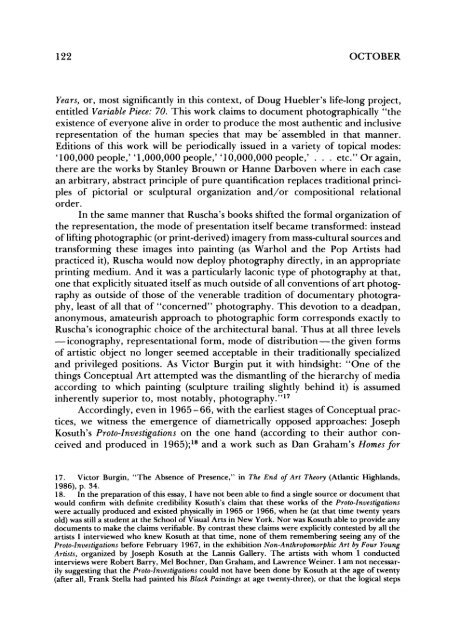Buchloh, conceptual art.pdf - Course Materials Repository
Buchloh, conceptual art.pdf - Course Materials Repository
Buchloh, conceptual art.pdf - Course Materials Repository
Create successful ePaper yourself
Turn your PDF publications into a flip-book with our unique Google optimized e-Paper software.
122 OCTOBER<br />
Years, or, most significantly in this context, of Doug Huebler's life-long project,<br />
entitled Variable Piece: 70. This work claims to document photographically "the<br />
existence of everyone alive in order to produce the most authentic and inclusive<br />
representation of the human species that may be'assembled in that manner.<br />
Editions of this work will be periodically issued in a variety of topical modes:<br />
'100,000 people,' '1,000,000 people,' '10,000,000 people,' . . . etc." Or again,<br />
there are the works by Stanley Brouwn or Hanne Darboven where in each case<br />
an arbitrary, abstract principle of pure quantification replaces traditional principles<br />
of pictorial or sculptural organization and/or compositional relational<br />
order.<br />
In the same manner that Ruscha's books shifted the formal organization of<br />
the representation, the mode of presentation itself became transformed: instead<br />
of lifting photographic (or print-derived) imagery from mass-cultural sources and<br />
transforming these images into painting (as Warhol and the Pop Artists had<br />
practiced it), Ruscha would now deploy photography directly, in an appropriate<br />
printing medium. And it was a p<strong>art</strong>icularly laconic type of photography at that,<br />
one that explicitly situated itself as much outside of all conventions of <strong>art</strong> photography<br />
as outside of those of the venerable tradition of documentary photography,<br />
least of all that of "concerned" photography. This devotion to a deadpan,<br />
anonymous, amateurish approach to photographic form corresponds exactly to<br />
Ruscha's iconographic choice of the architectural banal. Thus at all three levels<br />
-iconography, representational form, mode of distribution -the given forms<br />
of <strong>art</strong>istic object no longer seemed acceptable in their traditionally specialized<br />
and privileged positions. As Victor Burgin put it with hindsight: "One of the<br />
things Conceptual Art attempted was the dismantling of the hierarchy of media<br />
according to which painting (sculpture trailing slightly behind it) is assumed<br />
inherently superior to, most notably, photography.""7<br />
Accordingly, even in 1965- 66, with the earliest stages of Conceptual practices,<br />
we witness the emergence of diametrically opposed approaches: Joseph<br />
Kosuth's Proto-Investigations on the one hand (according to their author conceived<br />
and produced in 1965);18 and a work such as Dan Graham's Homes for<br />
17. Victor Burgin, "The Absence of Presence," in The End of Art Theory (Atlantic Highlands,<br />
1986), p. 34.<br />
18. In the preparation of this essay, I have not been able to find a single source or document that<br />
would confirm with definite credibility Kosuth's claim that these works of the Proto-Investigations<br />
were actually produced and existed physically in 1965 or 1966, when he (at that time twenty years<br />
old) was still a student at the School of Visual Arts in New York. Nor was Kosuth able to provide any<br />
documents to make the claims verifiable. By contrast these claims were explicitly contested by all the<br />
<strong>art</strong>ists I interviewed who knew Kosuth at that time, none of them remembering seeing any of the<br />
Proto-Investigations before February 1967, in the exhibition Non-Anthropomorphic Art by Four Young<br />
Artists, organized by Joseph Kosuth at the Lannis Gallery. The <strong>art</strong>ists with whom I conducted<br />
interviews were Robert Barry, Mel Bochner, Dan Graham, and Lawrence Weiner. I am not necessarily<br />
suggesting that the Proto-Investigations could not have been done by Kosuth at the age of twenty<br />
(after all, Frank Stella had painted his Black Paintings at age twenty-three), or that the logical steps
















